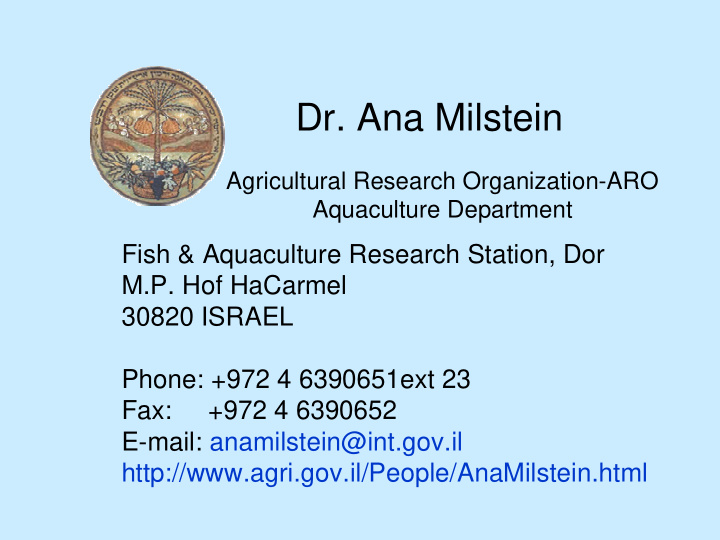



Dr. Ana Milstein Agricultural Research Organization-ARO Aquaculture Department Fish & Aquaculture Research Station, Dor M.P. Hof HaCarmel 30820 ISRAEL Phone: +972 4 6390651ext 23 Fax: +972 4 6390652 E-mail: anamilstein@int.gov.il http://www.agri.gov.il/People/AnaMilstein.html
Organic Tilapia Culture in Israel Ana Milstein 1 and Omri Lev 2 1 Fish & Aquaculture Research Station, Dor. 2 Kibbuts Geva Fish Farm.
demand of ‘healthy’ foods environmental concern public pressure World 'Organic' Retail Market billion U$ 80 60 40 20 0 year 1997 2000 2008 (Estimated growth rate: about 18 % per year (world average)
Organic aquaculture cold water species mainly salmonids warm water shrimps warm water fish: tilapia
Basis of ‘organic’ aquaculture production ! maintenance of the aquatic environment and surrounding ecosystems ! reduce environmental impact of effluents and wastes ! encouraged use of by-products and waste materials as feed source ! enhancement of biological cycles in production units
Basis of ‘organic’ aquaculture production ! reduced stocking density ! prohibition of genetically modified organisms (GMO) ! prohibition of synthetic fertilizers ! prohibition of hormones ! avoidance of chemotherapeutic agents ! promotion of polyculture when applicable
GMO ‘Organic’ fishpond " at Geva fish farm environment (3.5 ha) Bighead carp Silver carp ‘Organic’ manure Red Tilapia drum & feed Nutrients Mullet Common carp Grass carp
Commercial organic tilapia production in Israel Geva fish-farm, 1 pond of 3.5 ha, years 2000-2003 Stocking Harvesting Fish Observations (number/ha) (ton) 8,000-12,000 5-13 tilapia 80-90% of fish mullet 1,500 in 2000-2001 2-3 temp>30°C surv 50% $ $ common carp $ $ black carp restocked each year $ $ grass carp restocked each year $ $ silver carp restocked each year 500 0.3 red-drum 5% of fish, 6g at st. TOTAL 11,000-14,000 9-20 reduced since 2001: wild tilapia 3 # 1 cross of genetic lines spawning that give less females
‘Organic’ tilapia production problem: wild spawning Tilapia wild Pradator fish Genetic tilapia lines spawning Improved Tilapia wild spawning production
‘Organic’ tilapia production problem: feed must also be ‘organic’ Conventional feeds ‘ Organic ’ feeds Protein sources: Prohibited -- soja…………mostly GMO Allowed only -- fishmeal……fisheries are up to 5% not ‘organic’ 14% protein ‘organic’ feed pellets
‘Organic’ tilapia production problem: feed must also be ‘organic’ 30% protein ‘Organic’ feeds ‘organic’ Protein sources: feed pellets -- ‘organic’ soja $ -- fishmeal up to 5% Feed price doubles May compromise profitability
Periphyton based ‘organic’ tilapia production trial
Tilapia Oreochromis aureus stocking: 3-Jul-2003 each half pond = 250 m 2 number biomass mean weight (g) (kg) periphyton 258 64.660 250 side feed side 258 65.100 252
gram Tilapia weight, Geva 2003 600 400 200 periphyton feed 0 01-Jul 29-Jul 26-Aug 23-Sep 21-Oct
Tilapia harvesting: 2-Nov-2003, 122 culture days, each half pond = 250 m 2 periphyton side feed side fish number 248 236 biomass (kg) 111 107 mean weight (g) 446 455 survival (%) 96 91 growth (g/day) 1.61 1.68 yield (kg) 48.6 48.4 wild spawn. (kg) 13 10 feed (kg) 800 manure (kg) 90
Conclusions: ! tilapia actively feeds on periphyton ! periphyton-based aquaculture is appropriate to reduce costs and allow an economically viable organic tilapia production
Thanks
Recommend
More recommend